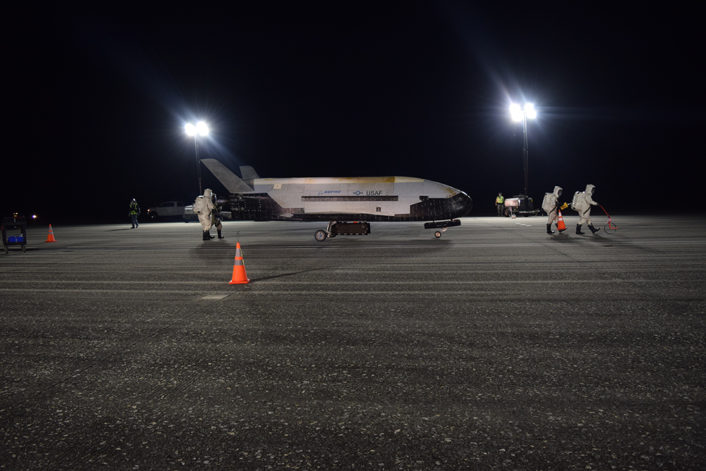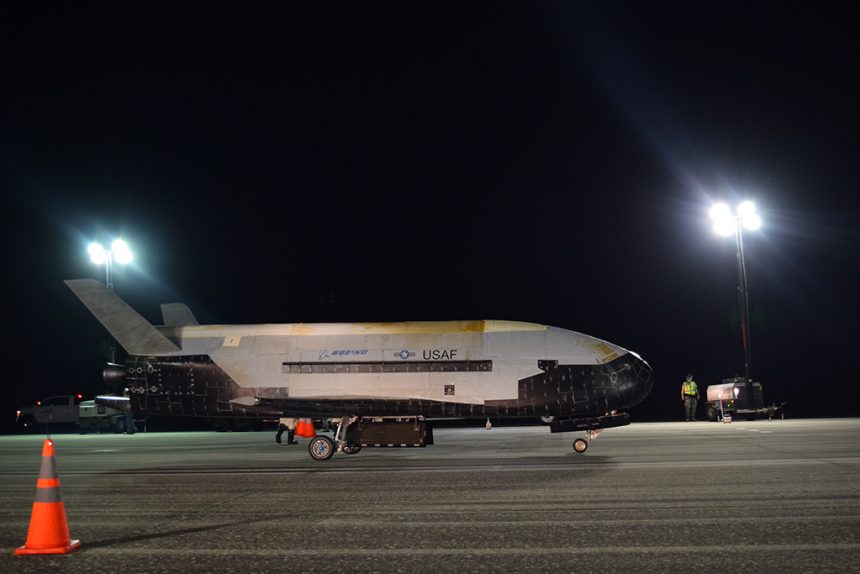The Air Force’s X-37B successfully landed at NASA’s Kennedy Space Center Shuttle Landing Facility earlier today. And here are a couple of interesting shots.
On Oct. 27, 2019 at 3:51 AM, the X-37B Orbital Test Vehicle Mission 5 touched down at NASA’s KSCLF after breaking its own record (the previous one, achieved during Mission 4 lasted 718 days) and spending 780 days conducting classified on-orbit experiments. The result is even more impressive if we consider that the spaceplane was designed for an on-orbit duration of “only” 270 days: as of today, the total number of days spent on-orbit for the entire test vehicle program is 2,865 days.
X-37B Mission 5 launched on Sept. 7, 2017, from Cape Canaveral Air Force Station (CCAFS), Florida on-board a Space X Falcon 9 booster. During the mission, earlier this year, noted Dutch astronomer and satellite expert Ralf Vandebergh was able to capture some rare photos of the secret military spacecraft:
The #OTV5 / #X37B space plane photographed in orbit! Finally an image showing this mini-Space Shuttle which is only a fraction in size of the real Shuttle. https://t.co/r7zqATUpN4 @SPACEdotcom @planet4589 @Marco_Langbroek @Astroguyz @govertschilling @phi48 @Sterne_Weltraum pic.twitter.com/a5RvgnHPFB
— Ralf Vandebergh (@ralfvandebergh) July 3, 2019
This was the second time the X-37B landed at the Kennedy Space Center Shuttle Landing Facility.
Managed by the Air Force Rapid Capabilities Office, the X-37B is the Air Force’s premier reusable and unmanned spacecraft, providing the performance and flexibility to improve technologies in a way that allows scientists and engineers to recover experiments tested in a long-duration space environment.
This is what we wrote about the X-37B in a recent post about here at The Aviationist:
The Air Force’s X-37B began as a test project with NASA in 1999 but was acquired by the U.S. Department of Defense in 2004. Most sources list two operational X-37B spacecraft and a single X-37A. The fact that only three exist, their missions and roles are classified and they operate in space makes them incredibly difficult to get photos of, especially when performing an active mission as in Vandebergh’s photos.
Little is known about the current role of the two X-37Bs and the single X-37A. Most likely the X-37Bs are in some form of “operational test” use with the USAF while the X-37A reportedly remains a combined Defense Advanced Research Projects Agency (DARPA) and NASA spacecraft with an equally secretive role.
While most information in the public domain lists both the X-37B and X-37A as “test” vehicles, the X-37B has performed unusually long duration space flights for testing. Remarkably, the current mission being performed by the X-37B in Vandebergh’s photos is designated “Mission OTV-5”. This mission began 670 days ago on September 7, 2017 when it was boosted into orbit on the SpaceX Falcon 9 orbital delivery spacecraft that launched from the NASA facility at Kennedy Space Center in Florida
The U.S. Air Force is preparing to launch the sixth X-37B mission from CCAFS in 2020. Meanwhile, enjoy a couple of shots the U.S. Air Force has just released.










